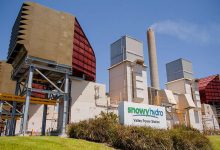Snowy Hydro is looking at building more gas fired generators, in addition the $600 million Kurri Kurri plant currently under construction in the Hunter Valley, saying surging electricity prices are presenting an opportunity for gas plants to make “ridiculous amounts of money”.
Speaking at the Australian Energy Week conference on Wednesday, Snowy Hydro chief commercial officer Gordon Wymer said Snowy Hydro is already preparing plans to build further gas peaking generators after its current, controversial and government-funded 660MW Kurri Kurri development is completed.
Wymer said that gas generators are set to make significant profits in the current energy market and that Snowy Hydro is already signing contracts at prices well above earlier assumptions.
“Never in my life have I seen a pricing signal as clear as long term and as obvious as what is there now, if you were to commit to a gas peaker now,” Wymer said.
“And by the way, we’re going to try to build more, but we’ll see what our shareholder says about that,” Wymer added, in reference to the federal government, which owns Snowy Hydro.
“If you build a gas plant now, you will make ridiculous amounts of money. And we’re saying this quite openly, and we wish other people would get on with it because we can’t build them all.”
The Kurri Kurri project, which was commissioned by the Morrison government with a $600 million injection of taxpayer funds into Snowy Hydro, was pitched as being necessary to lower electricity prices and improve the reliability of electricity supplies.
But Wymer’s assessment suggests the project is set to deliver significant profits to Snowy Hydro, at the expense of energy consumers.
Wymer said that the surge in wholesale electricity prices – which are currently contributing to significant increases in retail electricity prices – has allowed Snowy Hydro to sign ‘capacity contracts’ at very high prices.
“In our business case for Kurri Kurri, we assumed the $300 per MWh cap for capacity contracts. And we were told at the time, ‘Snowy Hydro is wasting money, government’s funding the disaster, they don’t know what they’re doing’,” Wymer said.
“So what’s happening now is we’ve sold capacity products at 50 to 300 per cent, above our assumption for the business case.”
During his address, Wymer rejected suggestions from Alinta Energy CEO Jeff Dimery – who had earlier addressed the Australian Energy Week conference – that coal fired generators could remain within the energy system as it underwent a process of decarbonisation.
“We need firming energy. So the coal guys would say, ‘we need firming energy and firming capacity, and that must mean to decarbonise we need more coal’,” Wymer said.
“And if that isn’t the best Catch-22 I’ve ever heard, I don’t know what is.”
Wymer instead insisted that the path to decarbonisation could be achieved by building more gas fired generators.
“When people say you’ve got to keep coal on, the truth is, every single gas plant that is built knocks out 10 per cent of the state’s electricity emissions,” Wymer said.
“This is not trivial. You build ten of them and you’re there.”
While gas fired generation has a lower emissions intensity compared to coal fired generation – it is still significant compared to renewable energy technologies.
The International Energy Agency has suggested that all unabated coal and gas generation would need to be phased out in developed economies by 2035, to put the world on a trajectory to reach zero net emissions by 2050.









